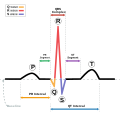QRS complex
QRS complex is a series of deflections on an electrocardiogram (ECG) that represents the electrical activity of the heart during ventricular depolarization. The QRS complex is normally the most noticeable feature on the ECG.
Overview[edit]
The QRS complex is a result of the simultaneous activation of the right and left ventricles. Although it is usually more prominent than the other waves, it is not always the largest wave of the ECG. The size of the QRS complex can be influenced by various factors such as the distance between the heart and the electrodes, the mass of the ventricles, and the direction and velocity of the ventricular activation wave.
Components[edit]
The QRS complex consists of three individual waves: the Q wave, the R wave, and the S wave. The Q wave represents the initial negative deflection, the R wave is the initial positive deflection, and the S wave is the subsequent negative deflection. However, not all QRS complexes contain all three waves. The configuration of the QRS complex can vary widely among individuals, and it can also be influenced by the heart rate and the direction of the heart's electrical axis.
Clinical significance[edit]
The duration, amplitude, and morphology of the QRS complex are important indicators of many cardiac conditions. For example, a prolonged QRS duration can indicate a bundle branch block or ventricular tachycardia. A low-amplitude QRS complex can suggest a pericardial effusion or cardiomyopathy. Abnormal QRS morphology can be a sign of a previous myocardial infarction or a ventricular hypertrophy.
See also[edit]
Ad. Transform your life with W8MD's Budget GLP-1 injections from $75


W8MD offers a medical weight loss program to lose weight in Philadelphia. Our physician-supervised medical weight loss provides:
- Weight loss injections in NYC (generic and brand names):
- Zepbound / Mounjaro, Wegovy / Ozempic, Saxenda
- Most insurances accepted or discounted self-pay rates. We will obtain insurance prior authorizations if needed.
- Generic GLP1 weight loss injections from $75 for the starting dose.
- Also offer prescription weight loss medications including Phentermine, Qsymia, Diethylpropion, Contrave etc.
NYC weight loss doctor appointmentsNYC weight loss doctor appointments
Start your NYC weight loss journey today at our NYC medical weight loss and Philadelphia medical weight loss clinics.
- Call 718-946-5500 to lose weight in NYC or for medical weight loss in Philadelphia 215-676-2334.
- Tags:NYC medical weight loss, Philadelphia lose weight Zepbound NYC, Budget GLP1 weight loss injections, Wegovy Philadelphia, Wegovy NYC, Philadelphia medical weight loss, Brookly weight loss and Wegovy NYC
|
WikiMD's Wellness Encyclopedia |
| Let Food Be Thy Medicine Medicine Thy Food - Hippocrates |
Medical Disclaimer: WikiMD is not a substitute for professional medical advice. The information on WikiMD is provided as an information resource only, may be incorrect, outdated or misleading, and is not to be used or relied on for any diagnostic or treatment purposes. Please consult your health care provider before making any healthcare decisions or for guidance about a specific medical condition. WikiMD expressly disclaims responsibility, and shall have no liability, for any damages, loss, injury, or liability whatsoever suffered as a result of your reliance on the information contained in this site. By visiting this site you agree to the foregoing terms and conditions, which may from time to time be changed or supplemented by WikiMD. If you do not agree to the foregoing terms and conditions, you should not enter or use this site. See full disclaimer.
Credits:Most images are courtesy of Wikimedia commons, and templates, categories Wikipedia, licensed under CC BY SA or similar.
Translate this page: - East Asian
中文,
日本,
한국어,
South Asian
हिन्दी,
தமிழ்,
తెలుగు,
Urdu,
ಕನ್ನಡ,
Southeast Asian
Indonesian,
Vietnamese,
Thai,
မြန်မာဘာသာ,
বাংলা
European
español,
Deutsch,
français,
Greek,
português do Brasil,
polski,
română,
русский,
Nederlands,
norsk,
svenska,
suomi,
Italian
Middle Eastern & African
عربى,
Turkish,
Persian,
Hebrew,
Afrikaans,
isiZulu,
Kiswahili,
Other
Bulgarian,
Hungarian,
Czech,
Swedish,
മലയാളം,
मराठी,
ਪੰਜਾਬੀ,
ગુજરાતી,
Portuguese,
Ukrainian





